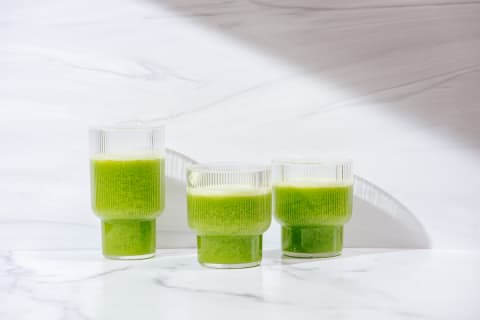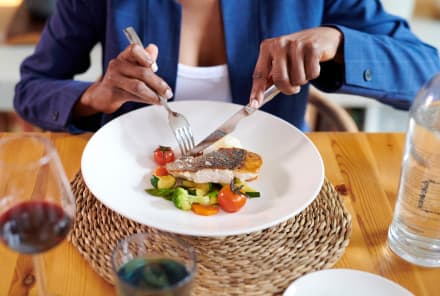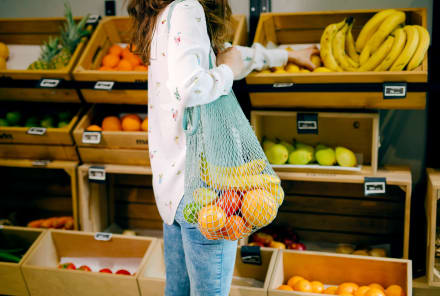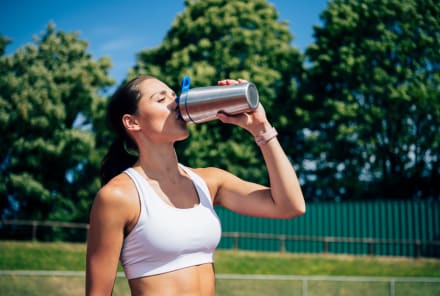Advertisement
Drinks For Period Cramps: What To Sip & Avoid, According To Nutrition Science

All period cramps are uncomfortable, and they can be downright debilitating for some. Fortunately, there are many ways to soothe period cramps—including staying properly hydrated.
Chances are you're already drinking plenty of water when your period strikes, but a handful of other tasty drinks can go even further for keeping aches away during this time.
Here are six drinks (beyond plain water) that may help with period cramps, plus beverages to avoid and other ways to relieve period cramps fast.
A quick look at drinks to help with period cramps:
- Ginger tea & ginger shots
- Magnesium drinks
- Green tea
- Beet juice
- Turmeric tea & golden milk
- Chamomile tea
The need-to-knows:
- Bring on the water & anti-inflammatory bevs: Certain drinks, like ginger tea and magnesium beverages, have anti-inflammatory and antispasmodic properties that may help soothe period cramp pain. Drinking at least 8 cups of water a day can also be an effective way to combat period cramps.
- You don't need to wait until your period to drink them: You can take a more proactive approach to period pain by consuming anti-inflammatory ingredients throughout the month, either in the form of drinks or daily supplements.
- Avoid added sugar: Cutting back on beverages like sugary sodas may reduce period pain. Caffeine and alcohol may also exacerbate some people's symptoms, so pay attention to how they make you feel.
What to drink to ease period cramps
Period cramps—referred to as dysmenorrhea in the medical field—impact as much as 95% of women of reproductive age1 worldwide.
Ensuring you're drinking plenty of water around and during your period may help reduce period cramps and even shorten period duration. That's because drinking water and maintaining proper hydration helps reduce your body's concentration of a hormone called vasopressin, which plays a role in period cramping2 by increasing uterine contractions and decreasing uterine blood flow.
A 2021 study published in BMC Women's Health found that women with dysmenorrhea who drank 2,000 milliliters (about eight cups) of water per day for two menstrual cycles had less severe period pain2, shorter periods, and took less pain medication during their periods compared to women who drank less than 1,600 ml (6.5 cups) of water per day.
However, you may be able to increase the period-cramp-reducing effects of your beverages by choosing drinks that contain substances known to have anti-inflammatory and pain-reducing effects. Here are six evidence-based drinks for period pain:
Ginger tea and ginger shots
Ginger contains a variety of active plant compounds with powerful anti-inflammatory, pain-relieving, and antispasmodic properties such as gingerols, shogaols, and paradols. Taking ginger supplements and drinking ginger drinks, like ginger tea and concentrated ginger shots, may help relieve period cramps.
A 2021 review3 of eight studies published in Cureus found that ginger treatments were more helpful for relieving period pain than placebo treatments and that ginger was as effective for reducing period pain severity as NSAIDs.
Try making ginger tea with fresh or powdered ginger, lemon juice, and honey for a comforting and natural way to soothe cramps.
Magnesium drinks
Not only is magnesium essential for overall physical and mental health, but maintaining optimal magnesium levels could help reduce period cramp severity.
Studies show that having low magnesium levels is associated with dysmenorrhea4 and that increasing magnesium intake could help reduce period cramp frequency and severity. A 2022 study that included 172 women with dysmenorrhea found that treatment with 200 milligrams (mg) of magnesium citrate per day during their period significantly reduced pelvic pain5 and significantly reduced the need for painkillers.
Magnesium has also been shown to help prevent excessive uterine contractions6 and relax muscles in the uterus, which could ease period cramps.
You can get magnesium through food and supplements. Powdered magnesium supplements can also be added to liquids like water, tea, and smoothies.
"Magnesium drinks may help alleviate cramps because they help the smooth muscle of the uterus, which is where the contractions are when you are cramping," family medicine physician Bindiya Gandhi, M.D., tells mindbodygreen.
Green tea
Green tea intake is linked with some impressive health benefits, from reducing depression risk7 to protecting against heart disease8.
In addition to supporting overall health, research shows that drinking green tea may help reduce uterine contractions9 and improve hyperalgesia, or increased pain sensitivity, which is associated with dysmenorrhea. A 2019 study published in BMJ Open that included 1,183 Chinese women found that drinking green tea was associated with a 37% lower risk of mild dysmenorrhea10 and a 58% reduced risk of moderate to severe dysmenorrhea.
Beet juice
Beets and beet juice are a rich source of anti-inflammatory and antioxidant substances that may help reduce period pain.
For starters, they're high in nitrates, which are converted to nitric oxide in the body. Nitric oxide is a powerful blood vessel dilator that helps improve blood flow11 throughout the body, including in the uterus. In addition to nitrates, beets contain anti-inflammatory substances like betalains, which may also help ease period cramps.
A 2022 study found that teen girls who drank 150 ml (half a cup) of beet juice daily for two days experienced significant reductions11 in period pain compared to before the treatment.
Turmeric tea and golden milk
Turmeric, which is known for its anti-inflammatory and pain-relieving effects, may be helpful when you're experiencing period cramps.
Turmeric can be taken in supplement form and can also be added to food and drinks. Sipping on turmeric tea or golden milk is an easy and delicious way to flood your body with curcumin, an anti-inflammatory polyphenol compound concentrated in turmeric.
A 2021 study published in the Journal of Surgery and Medicine found that women treated with the pain reliever Naproxen plus 1,000 mg of turmeric powder daily during their period had more significant reductions in their pain levels compared to women treated with Naproxen alone. Other studies also show that combination treatment with turmeric and NSAIDs12 like mefenamic acid is much more effective for reducing period pain compared to NSAIDs alone.
Chamomile tea
In addition to helping you de-stress during your period, drinking chamomile tea may provide period cramp relief. Chamomile contains compounds like13 apigenin, quercetin, methoxy-coumarin, matrisin, and bisabolol, which have antispasmodic13 and anti-inflammatory effects.
Chamomile tea may help decrease pain sensation by inhibiting cyclooxygenase (COX) enzymes that contribute to inflammation and pain13. Studies show that consuming chamomile may also help reduce menstrual bleeding, making chamomile tea a smart choice for those with heavy and painful periods. A 2021 review of seven studies concluded that chamomile is effective for reducing period cramps14 and heavy menstrual bleeding.
A note on smoothies & juices
In addition to the drinks listed above, adding smoothies and green juices to your diet can also be helpful—as long as they're not packed with ingredients that will cause a blood sugar spike. The most nutritious green juices and smoothies contain fiber, protein, and healthy fats, as well as antioxidant-rich fruits and vegetables to help protect against period pain15.
Gandhi recommends adding fresh pineapple to your green juices and smoothies, as the bromelain found in pineapple has anti-inflammatory effects16 and may help reduce inflammation and cramping. Here's her go-to recipe:
An MD's favorite smoothie for period cramp relief:

Ingredients:
- 1 cup spinach
- 1 cucumber
- ¼ of a pineapple (~1.25 cups)
- 1 teaspoon turmeric
- 1 teaspoon grated fresh ginger
- 1 cup coconut water (optional)
Method:
- Blend the ingredients with 1 cup of coconut water or regular water until smooth.
Drinks to avoid when you're having your period
While some drinks may help with period cramps, others can make them worse. According to research findings, people who frequently consume energy drinks, soda, and sugary drinks may be at a higher risk for 17dysmenorrhea.
High sugar intake, which is linked to more severe period pain18, may stoke inflammation in the body, which could worsen period pain and other inflammation-mediated conditions.
Some study findings suggest that caffeinated and alcoholic drink consumption19 may worsen period cramps, while others show no significant association17 between their intake and severe period cramps. Research on diet and its effect on menstrual cramps is limited, so it's important to make dietary changes based on your specific needs and sensitivities.
What about coffee?
Some studies have found that caffeinated drinks19 may worsen period cramps, while others linked these beverages to protection17 against severe period cramps.
A 2021 study demonstrated that women who drank one to three cups of caffeinated beverages per day were 1.8 times more likely20 to experience period-related pain compared to those who drank less than one cup of caffeinated beverage per day.
However, other studies have found no link between caffeine consumption and dysmenorrhea severity21.
Caffeine has blood-vessel-constricting effects22, which may worsen pelvic pain in some women, but it's unclear if drinking caffeinated drinks, like coffee, triggers period pain in all women. If you find that coffee and other caffeinated drinks make your period symptoms worse, consider switching to decaf or trying an herbal tea, like chamomile.
Summary
Are any alcohols OK?
Based on current research findings, alcohol doesn't seem to have a significant impact23 on period cramp severity. In fact, some studies have linked alcohol consumption with reduced period pain17.
However, this doesn't mean you should turn to alcoholic drinks when you're experiencing cramps. Alcohol can lead to many other health issues, from liver disease to mental health conditions, especially when consumed in large amounts.
But if you'd like to have an alcoholic drink during your period, it's unlikely to make your cramps worse. That said, since added sugar seems to worsen period pain in some people, it's best to stick to low-sugar drinks, like dry wine or vodka and seltzer.
Summary
Other ways to relieve cramps fast
Already have your chamomile tea brewing and green smoothie in the blender? Here are a few additional ways to relieve period cramps quickly and holistically:
- Try a supplement: Studies show that certain dietary supplements, like magnesium, vitamin D24, vitamin E25, turmeric, and omega-3s26 regularly could be helpful for reducing the severity of pain when your period comes around. Work with your health care provider to find a targeted supplement regimen that works for you.
- Get moving: Exercising may be the last thing on your mind when you're having period cramps, but staying active could significantly decrease27 period pain intensity. Walking, jogging, yoga, and even gentle stretching are some of the exercises linked to improvements in period pain. Exercise improves blood flow, increases pain-relieving substances like endorphins, and suppresses proinflammatory proteins, all of which may improve period pain28.
- Try heat therapy: Heat therapy is a doctor-recommended and evidence-based way to improve period pain. A 2018 review of six studies found that heat therapies helped decrease period pain29 in women with dysmenorrhea. Whether you pop in a sauna or steam room or use a heating pad or infrared mat, it could offer some fast comfort.
The mindbodygreen POV
Staying hydrated is always important but especially once your period hits. The next time you suffer from period pain, drinking at least eight cups of water daily will help. For further relief, you can also sip beverages with anti-inflammatory and antispasmodic properties—like green tea, turmeric lattes, and beet juice.
These botanicals aren't just helpful once your period strikes. You can take a more proactive approach to period pain by consuming them throughout the month, either in the form of drinks or daily supplements.
Avoid drinks that have added sugar around your period, and be mindful of how caffeine and alcohol make you feel. Other ways to support your body through period pain include doing gentle exercise and getting heat therapy in the form of a sauna, heating pad, or infrared mat.
—Emma Loewe, mindbodygreen Health & Sustainability Director
This doesn't apply to you if:
While certain drinks may help with period cramp pain, they shouldn't be used to treat severe symptoms. "Excessive cramping could be a warning sign of something else going on, so it's important to always seek help from a qualified health care provider," says Gandhi.
If you've noticed that your period pain is getting worse or is impacting your quality of life, make an appointment with a gynecologist. They can help you get to the bottom of your pain and recommend appropriate and effective treatments.
FAQ
What is the best alcohol for menstrual cramps?
There is no "best" alcohol for menstrual cramps. That said, choosing low-sugar beverages may help reduce period cramp severity as taking in too much added sugar has been linked to period cramp severity.
What drinks should you avoid during menstruation?
Cutting back on sugary drinks, like soda, energy drinks, and sweetened coffee drinks, and replacing them with water, herbal tea, and other period-cramp-friendly drinks may help decrease period symptoms.
The takeaway
Period cramps can be brutal, but there are several ways to reduce their severity and frequency. Keeping your body hydrated by sipping on drinks that contain anti-inflammatory and antispasmodic ingredients, such as magnesium drinks, beet juice, ginger tea, and chamomile tea, may be an effective way to reduce period cramp pain so you can get back to your normal routine. Certain supplements can also help ease painful symptoms—here are a few to look into.
29 Sources
- https://www.ncbi.nlm.nih.gov/pmc/articles/PMC8943241/
- https://www.ncbi.nlm.nih.gov/pmc/articles/PMC7845092
- https://www.ncbi.nlm.nih.gov/pmc/articles/PMC8021506/
- https://pubmed.ncbi.nlm.nih.gov/28392498/
- https://www.ncbi.nlm.nih.gov/pmc/articles/PMC9800031/
- https://www.ncbi.nlm.nih.gov/pmc/articles/PMC10460502/
- https://pubmed.ncbi.nlm.nih.gov/35768246/
- https://www.ncbi.nlm.nih.gov/pmc/articles/PMC9548982/
- https://www.ncbi.nlm.nih.gov/pmc/articles/PMC10054707/
- https://www.ncbi.nlm.nih.gov/pmc/articles/PMC6500245/
- https://www.ncbi.nlm.nih.gov/pmc/articles/PMC10259228/
- https://pubmed.ncbi.nlm.nih.gov/32585392/
- https://www.ncbi.nlm.nih.gov/pmc/articles/PMC6970572/
- https://www.ncbi.nlm.nih.gov/pmc/articles/PMC8242407/
- https://www.ncbi.nlm.nih.gov/pmc/articles/PMC7858019/
- https://www.ncbi.nlm.nih.gov/pmc/articles/PMC9463608
- https://www.ncbi.nlm.nih.gov/pmc/articles/PMC9013668/
- https://www.ncbi.nlm.nih.gov/pmc/articles/PMC10178419/
- https://www.ncbi.nlm.nih.gov/pmc/articles/PMC9148642/
- https://www.ncbi.nlm.nih.gov/pmc/articles/PMC8013909/
- https://www.ncbi.nlm.nih.gov/pmc/articles/PMC9819475
- https://www.ncbi.nlm.nih.gov/pmc/articles/PMC6454168/
- https://www.ncbi.nlm.nih.gov/pmc/articles/PMC10422913/
- https://www.ncbi.nlm.nih.gov/pmc/articles/PMC6856484/
- https://www.ncbi.nlm.nih.gov/pmc/articles/PMC10303710/
- https://pubmed.ncbi.nlm.nih.gov/35059756/
- https://www.ncbi.nlm.nih.gov/pmc/articles/PMC6753056/
- https://www.ncbi.nlm.nih.gov/pmc/articles/PMC8918380/
- https://www.ncbi.nlm.nih.gov/pmc/articles/PMC6214933/
Watch Next
Enjoy some of our favorite clips from classes
Enjoy some of our favorite clips from classes
What Is Meditation?
Mindfulness/Spirituality | Light Watkins
Box Breathing
Mindfulness/Spirituality | Gwen Dittmar
What Breathwork Can Address
Mindfulness/Spirituality | Gwen Dittmar
The 8 Limbs of Yoga - What is Asana?
Yoga | Caley Alyssa
Two Standing Postures to Open Up Tight Hips
Yoga | Caley Alyssa
How Plants Can Optimize Athletic Performance
Nutrition | Rich Roll
What to Eat Before a Workout
Nutrition | Rich Roll
How Ayurveda Helps Us Navigate Modern Life
Nutrition | Sahara Rose
Messages About Love & Relationships
Love & Relationships | Esther Perel
Love Languages
Love & Relationships | Esther Perel
What Is Meditation?
Box Breathing
What Breathwork Can Address
The 8 Limbs of Yoga - What is Asana?
Two Standing Postures to Open Up Tight Hips
How Plants Can Optimize Athletic Performance
What to Eat Before a Workout
How Ayurveda Helps Us Navigate Modern Life
Messages About Love & Relationships
Love Languages
Advertisement

Your Grandma's Go-To Supplement Is Once Again Popular (For A Good Reason)
Molly Knudsen, M.S., RDN

This Type Of Fat Is Vital For Women's Health — Are You Getting Enough?
Molly Knudsen, M.S., RDN

New Study Confirms The 3 Habits That Age Your Brain Faster
Molly Knudsen, M.S., RDN

Your Grandma's Go-To Supplement Is Once Again Popular (For A Good Reason)
Molly Knudsen, M.S., RDN

This Type Of Fat Is Vital For Women's Health — Are You Getting Enough?
Molly Knudsen, M.S., RDN

New Study Confirms The 3 Habits That Age Your Brain Faster
Molly Knudsen, M.S., RDN











